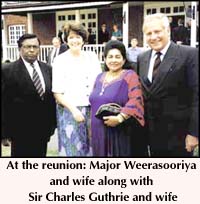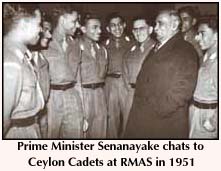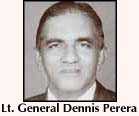
10th October 1999
Front Page|
News/Comment|
Editorial/Opinion| Business|
Sports | Sports
Plus| Mirror Magazine

![]()
Roll call 40 years on
The 23rd Intake of the Royal Military Academy in Sandhurst UK celebrated their 40th reunion on August 6. Here Major W.M. Weerasooriya who attended the reunion recollects the good old days at Sandhurst
The members of the 23rd Intake of the Royal Military Academy, Sandhurst, in the U.K. celebrated their 40th anniversary on August 6 this year. A reunion of batch members took place at Sandhurst, coinciding with the passing out parade of the Academy.
 Major
W.M. Weerasooriya, who retired from the Sri Lanka Army many years ago,
was invited to this reunion. The invitation came from no less a person
than General Sir Charles Guthrie, Chief of the Defence Staff in the U.K.,
who initiated the reunion. "It was really a very pleasant surprise
when the Defence Advisor at the British High Commission in Colombo, Col.
Robert Kendall called me and told me that Gen. Sir Charles wished to contact
me," Major Weerasooriya said. "As I had retired from the Army,
I had lost contact with my batchmates at Sandhurst. I was happy and proud
to hear of the progress one of my close batchmates has made in the service,
particularly rising to the highest position that a service officer in the
U.K. could reach in his career."
Major
W.M. Weerasooriya, who retired from the Sri Lanka Army many years ago,
was invited to this reunion. The invitation came from no less a person
than General Sir Charles Guthrie, Chief of the Defence Staff in the U.K.,
who initiated the reunion. "It was really a very pleasant surprise
when the Defence Advisor at the British High Commission in Colombo, Col.
Robert Kendall called me and told me that Gen. Sir Charles wished to contact
me," Major Weerasooriya said. "As I had retired from the Army,
I had lost contact with my batchmates at Sandhurst. I was happy and proud
to hear of the progress one of my close batchmates has made in the service,
particularly rising to the highest position that a service officer in the
U.K. could reach in his career."
Major Weerasooriya and his wife attended the graduation parade, and met his batchmates from many countries, 40 years after their own graduation. He found that the parade was almost identical to the parades in his day. "The only difference was that Sandhurst now has a contingent of lady officers, which they unfortunately did not have in our days," he said.
Meeting friends from 40 years ago, naturally took their minds back to the old days, recalling almost forgotten incidents. Maj. Weerasooriya recalled how in his very first week, "The Sgt. who came to take roll call at night shouted 'stand at your doors'. Being half asleep, I came out in my pyjamas without my dressing gown. The Sgt.shouted at me to come out with the dressing gown on.
"While they all waited for me at the doors, I went back in and back to bed. Everyone was shocked and worried that I would be in trouble. To their surprise however, the Sgt. commented that I might not have understood what he shouted in English and left without a fuss."
Being the smallest in build in the batch also had its advantages for him. "On the first day, when uniforms were issued to us, they were put into the two 'sausages' as they were called, which we had to carry along with the rifle. We had to march back to our billet half a mile away at 180 paces a minute in civivies, carrying the sausages and the rifle. There was our instructor, Sgt. Day of Grenadier Guards who I thought felt sorry for me and carried one 'sausage' for me all the way. I am certain that was the only time such a thing happened at Sandhurst."
Maj. Weerasooriya says he thoroughly enjoyed his days at Sandhurst and so did the other overseas cadets in his batch. "We owe this to our British batch mates and everyone else in the company who were helpful and kind. We were never made to feel that we were foreigners." –HF
Another reunion
By Hiranthi Fernando
Whilst the Sri Lanka Army celebrates its 50th anniversary, Sri Lankan graduates of the prestigious Royal Military Academy Sandhurst (RMAS) are joining together in a reunion on October 15. This reunion marks 50 years since the first batch of officer cadets from the Sri Lankan Army were sent to Sandhurst for training.
 "We
joined the Sri Lanka Army on October 10, 1949, when it was inaugurated.
By the 12th, we were on our way to Sandhurst for training," said Lt.
General Dennis Perera, a former Army Commander, who was among the first
batch of cadets from Sri Lanka, to be sent to Sandhurst. "It took
us about two days to get there," he recalled. "The planes then
were not as fast as today. We made several stops to refuel. There was no
flying during the night. We slept on the plane for a few hours. We finally
reached Sandhurst on October 14."
"We
joined the Sri Lanka Army on October 10, 1949, when it was inaugurated.
By the 12th, we were on our way to Sandhurst for training," said Lt.
General Dennis Perera, a former Army Commander, who was among the first
batch of cadets from Sri Lanka, to be sent to Sandhurst. "It took
us about two days to get there," he recalled. "The planes then
were not as fast as today. We made several stops to refuel. There was no
flying during the night. We slept on the plane for a few hours. We finally
reached Sandhurst on October 14."
 Lt.
Gen. Perera said there were 10 cadets in that batch, among them Captain
A.J.B. Anghie, Brigadier A.P.R. David, General T.I. Weeratunga, Major Dalton
Anderson, and Lt. Col. V. Ramanathan. The other four, Brig. Justus Rodrigo,
Brig. Lawrence Fernando, Col. Noel Gunawardena and Capt. Nimal Jayakody
have passed away. Two of them, Lt. Gen. Perera and Gen. Weeratunga served
as Commanders of the Sri Lanka Army.
Lt.
Gen. Perera said there were 10 cadets in that batch, among them Captain
A.J.B. Anghie, Brigadier A.P.R. David, General T.I. Weeratunga, Major Dalton
Anderson, and Lt. Col. V. Ramanathan. The other four, Brig. Justus Rodrigo,
Brig. Lawrence Fernando, Col. Noel Gunawardena and Capt. Nimal Jayakody
have passed away. Two of them, Lt. Gen. Perera and Gen. Weeratunga served
as Commanders of the Sri Lanka Army.
The Royal Military Academy Sandhurst enjoys the reputation of being the foremost military academy in Britain and even in the world. Sandhurst, its predecessor the Royal Military College and the Staff College all owe their existence to Gaspard Le Marchant, a British cavalry officer who had a vision of an Army commanded by professionally educated officers. After his experiences in the protracted war against revolutionary France, he proposed an extended training system with three main departments.
A series of lectures commenced in May 1799 in temporary accommodation at an inn in High Wycombe, with 26 officers attending the course. In 1801, an estate on the Surrey-Berkshire border was purchased by the Government to house a Royal Military College. In June, the same year, a royal warrant formally creating the Royal Military College was issued. In March 1802, a further royal warrant created the Royal Military Cadet College for cadets aged thirteen to fifteen years on entry. This later became the junior department. A hundred cadets, sons of officers killed in active service, continued to receive a free education, even after fees were introduced. It was finally in 1812 that the Royal Military College, Sandhurst opened in the new building at Sandhurst. In 1947, the reconstituted Royal Military Academy opened, amalgamating with the older military academy at Woolich.
"Sandhurst was a great experience," Gen. Dennis Perera said. "It is an academy in a military background. We had a broad training in leadership and what being an officer means. We had the privilege of being instructed by officers who had just completed their war service. It was a tremendous experience for us who had no military background whatsoever."
After 20 months of training, the cadets participated in an impressive final passing out parade, known as the Sovereign's Parade. Marching up the steps, at the parade, symbolisesd their passing out and commissioning into the Army. The Sri Lankan cadets who had to specialize in engineering, artillery and signals went on to specialised training schools whilst the infantrymen returned to Sri Lanka.
"Sandhurst has trained 119 officers and produced seven Commanders of the Sri Lanka Army," Gen. Perera said. "I was the first and Gen. Daluwatte, the former Commander was the last. In due course, cadets from Sri Lanka were sent to Dehra Dunn in India and Kakul in Pakistan. In fact, the present Commander Lt. Gen. Srilal Weerasooriya was in the first batch of cadets who went to Pakistan." Although officers from the Sri Lanka Army still go to Sandhurst for courses, they now send one or two at a time and not in large batches. Since the Army now has to bear the cost of the training, it is expensive.
"Some officers trained at Sandhurst go back occasionally to visit the Academy," Gen. Dennis Perera said. "I had the privilege of being Military Attache in London and so had the opportunity to visit Sandhurst. I also went back there in 1979/80 as Commander of the Sri Lanka Army. I was received with great ceremony, unlike when we were thrown around as cadets. The ex-Sandhurst serving officers as well as retired officers meet occasionally though there is no organised association as such. "There is a lot of nostalgia for the place even though we were not there at the same time but spread over a period of fifty years," Gen. Perera commented. "On the occasion of this get-together, everyone who is in Sri Lanka and fit enough will attend. The Defence Advisor of the British High Commission will also be there since he too was trained at Sandhurst. We have invited The Army Commander Lt. Gen. Weerasooriya as the Chief Guest."
When the first batch of Ceylonese cadets went to Sandhurst, they were the only Asians there. Gen. Perera said Indian cadets had been there earlier, but they had started their own Academy at Dehra Dunn. Since there was a Defence Agreement between Britain and Sri Lanka, training facilities for the Ceylonese cadets were provided without any payment. Salaries for the cadets and the passages were paid for by the Ceylon government.
More Plus
![]()
Front Page| News/Comment| Editorial/Opinion| Business| Sports| Sports Plus| Mirror Magazine
Please send your comments and suggestions on this web site to









